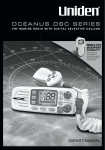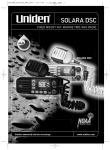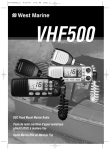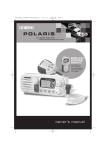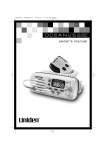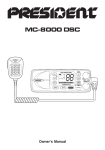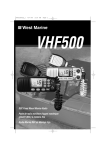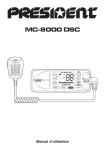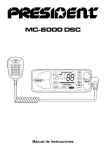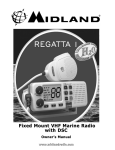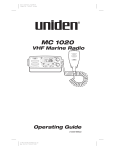Download Uniden OCEANUS ATIS Series Specifications
Transcript
OCEANUS DSC/ATIS_ENG_0512 5/12/05 10:34 AM Page i OCEANUS DSC/ATIS_ENG_0512 5/12/05 10:34 AM Page ii Contents Included with your OCEANUS DSC/ATIS ..............................................3 Controls and Indicators...........................................................................4 Installation...............................................................................................8 Choosing a Location..........................................................................8 Engine Noise Suppression ................................................................9 Antenna Considerations ....................................................................9 Antenna Selection and Installation ....................................................9 Installing the OCEANUS DSC/ATIS ................................................10 Operation ..............................................................................................11 Power On/Off ...................................................................................11 Last Channel Memory......................................................................11 Squelch............................................................................................12 Coast Guard Channel 16/Channel 9 Communications ...................13 Triple Watch.....................................................................................13 Manual Tuning .................................................................................14 MEM (Entering channel numbers into Memory Scan) ....................14 Triple Watch Scan ...........................................................................14 Normal Scan....................................................................................14 Transmitting .....................................................................................15 Setting TX Output ............................................................................15 Distress............................................................................................16 Marine Distress Procedure ..............................................................17 Menu Operation ....................................................................................18 Digital Selective Calling (DSC)........................................................18 Individual ....................................................................................18 Group .........................................................................................19 All Ships .....................................................................................20 Position Request ........................................................................21 Position Send .............................................................................23 Standby ......................................................................................24 Call Wait.....................................................................................25 Geographical Call ......................................................................26 OCEANUS DSC/ATIS_ENG_0512 5/12/05 10:34 AM Page iii Setup ...............................................................................................27 Alarm Clock ................................................................................27 Local Time Adjust.......................................................................30 Daylight Savings On/Off.............................................................31 Directory.....................................................................................32 Auto Channel Switch..................................................................36 Position Reply ............................................................................37 CH Tag .......................................................................................39 Group MMSI...............................................................................41 User MMSI .................................................................................42 ATIS ID .......................................................................................43 System.............................................................................................44 Contrast......................................................................................44 Lamp Adjust ...............................................................................45 Key Beep ...................................................................................46 Switching the Inland Waterway Mode/Seagoing Mode ........................47 NMEA Technical Setup .........................................................................48 Optional Accessories ............................................................................48 VHF FM Marine Radio Telephone Channel and Functions (International Channels) ...........................49 Specification .........................................................................................50 Troubleshooting ....................................................................................51 Care and Maintenance .........................................................................52 Declaration of Conformity .....................................................................52 OCEANUS DSC/ATIS_ENG_0512 5/12/05 10:34 AM Page 2 Uniden OCEANUS DSC/ATIS The Uniden OCEANUS DSC/ATIS VHF marine radio has been designed to give you a rugged, reliable instrument that will provide you with years of trouble-free service. With proper care and maintenance, your marine radio could outlast your present vessel and serve you well on-board. The full features and flexibility designed into this quality transceiver will prevent it from becoming obsolete regardless of changes in craft or geographic locations. The OCEANUS DSC/ATIS is of all solid-state design with conservatively rated, rugged components and materials compatible with the marine environment. The transceiver utilizes a number of gaskets, sealing rings, waterproof membranes, and other sealants to effect a waterproof housing for protection of the electronics. It meets the most stringent IPX7 waterproof specification. The unit may be mounted in any number of convenient locations on your vessel by utilizing the optional flash mount bracket (Black - FMB322B). You are encouraged to thoroughly read the rest of this Operating Guide to acquaint yourself with the characteristics and operation of your transceiver so that you can contribute to the longevity of your investment. Keep your receipt as proof-of-purchase in case warranty service is required. Features, specifications, and availability of optional accessories are all subject to change without notice. Note: OCEANUS DSC/ATIS meets IPX7 requirements. 2 OCEANUS DSC/ATIS_ENG_0512 5/12/05 10:34 AM Page 3 Included with your OCEANUS DSC/ATIS OCEANUS DSC/ATIS Owner’s Manual OCEANUS DSC/ATIS Radio Mounting Bracket and Knobs Mounting Hardware Microphone Hanger and Screws DC Cord Accessory Cable 3 Spare Fuse 250V 6A OCEANUS DSC/ATIS_ENG_0512 5/12/05 10:34 AM Page 4 Controls and Indicators Front panel/Microphone 5 678 9 1 2 3 2 4 10 11 12 13 14 15 1. PTT Switch - Press to transmit and release to receive. 2.5. CHANNEL/▲/▼- These keys are used to change the channel number up/down. These buttons are also used to move the cursor in Menu mode. 3.11. MENU - Press this key to enter the Menu mode. 4.10. SELECT - In the Menu mode this is used to select the menu options. 6. STEP/SCAN - Press this key to activate the step operation. Every time this key is pushed, the radio will step to the next channel that has placed into Memory. Pressing and holding this key for 2 seconds will activate the channel scan feature. 7. MEM - Pressing will place the currently selected channel into Memory. 8. PA/MODE - Press this key to enable the PA (Public Address) feature. Pressing and holding this key will switch between Inland Waterway mode and Seagoing mode. WX blinks on the display in Inland Waterway mode. 9. PWR/VOL (On/Off/Volume) - Turns the unit On or Off and adjusts the speaker volume. 12. HI/LO - Press this key to change the transmit power to either High or Low. 13. 16/9/TRI - Press this key instantly change to Channel 16, Channel 9 or current channel. Pressing and holding this key for 2 seconds will activate the triple Watch Feature. 14. DISTRESS - Press this key to send a signal of distress in case of emergency. 15. SQUELCH - Rotate this knob eliminate background noise when a signal is not being received. 4 OCEANUS DSC/ATIS_ENG_0512 5/12/05 10:34 AM Page 5 Rear Panel Connectors 1 1. 2. 3. 4. 2 3 4 ACC Connector To OCEANUS DSC/ATIS Note: DC13.8V and GND are for GPS ANT. 5 DC Jack ACC Connector Remote Connector Antenna Connector OCEANUS DSC/ATIS_ENG_0512 1. 2. 3. 4. 5. 6. 7. 8. 9. 10. 11. 5/12/05 10:34 AM Page 6 TX (Transmit) - Indicates transmitting. HI (High) - Indicates transmit output is 25 Watts. DSC - Indicators the radio is in the DSC mode. TRI (Triple Watch) - Indicates Triple Watch Mode is in effect. MEM (Memory) - Indicates Memory Scan Mode status for each channel selected. LO (Low) - Indicates transmit output is 1 Watt. WX - It blinks when the radio in the Inland Waterway mode. (GPS Icon) - It appears while GPS module is receiving the data. (Alarm Icon) - It appears when the alarm clock is set. CH TAG - This area is used for Channel Tag, Menu, and message of DSC, GPS. These messages will continually scroll from right to the left. Channel Display - Indicates Channel Number in use. 6 OCEANUS DSC/ATIS_ENG_0512 5/12/05 10:34 AM Page 7 Flow Chart for Menu Operation MENU DSC CALL SYSTEM SETUP INDIVIDUAL ALARM CLOCK CONTRAST GROUP LOCAL TIME ADJUST LAMP ADJUST ALL SHIPS DAYLITE SAVE KEY BEEP POS REQUEST DIRECTORY EXIT POS SEND AUTO CH SW STANDBY POS REPLY CALL WAIT CH TAG EXIT GROUP MMSI EXIT USER MMSI ATIS ID EXIT NOTES: "POS SEND", "LOCAL TIME ADJUST", "DAYLITE SAVE", and "ALARM CLOCK" are not displayed in Menu when GPS module is not connected. When the radio is in one of the following modes: Channel 16/9 mode, Scan Mode, or Triple Watch mode, and the user presses the Menu key, all of these modes are cancelled. The Menu mode will be cancelled if the radio receives a DSC call or EXIT is selected. 7 OCEANUS DSC/ATIS_ENG_0512 5/12/05 10:34 AM Page 8 Installation Caution: The OCEANUS DSC/ATIS will only operate with a nominal 12 volt negative ground battery system. It is important to carefully determine the most suitable location for your radio on your vessel. Electrical, mechanical, and environmental considerations must all be taken into account. You should select the optimum relationship among these considerations. Keep in mind the flexibility designed into the OCEANUS DSC/ATIS so that you can most conveniently use it. Features which should be considered are: 1. The universal mounting bracket may be installed on either the top or bottom of a shelf, on a bulkhead, or for overhead mounting. 2. The REMOTE speaker wires can be used with an auxiliary speaker. 3. All connections are "plug-in" type for easy removal of the radio. 4. Front fire internal speaker allows convenient in-dash mounting using the optional bracket (Black - FMB322B). Choosing a Location Some important factors to consider in selecting the location for your OCEANUS DSC/ATIS. 1. Select a location that is free from spray and splash. 2. Keep the battery leads as short as possible. Direct connection to the battery is most desirable. If direct connection can not be made with the supplied power lead, any extension should be made with 2.5 mm2 wire. Long extensions should use larger gauge wire. 3. Keep the antenna lead as short as possible. Long antenna leads can cause substantial loss of performance for both receiving and transmitting. 4. Locate your antenna as high as possible and clear from metal objects. The reliable range of coverage is a direct function of the antenna height. 5. Select a location that allows free air flow around the heat sink on the rear of the radio. 6. Select a location well away from the ship’s compass. Auxiliary speakers also should be located away from the compass. 8 OCEANUS DSC/ATIS_ENG_0512 5/12/05 10:34 AM Page 9 Engine Noise Suppression Interference from the noise generated by the electrical systems of engines is sometimes a problem with radios. The OCEANUS DSC/ATIS has been designed to be essentially impervious to ignition noise and alternator noise. However, in some installations it may be necessary to take measures to further reduce the effect of noise interference. All DC battery wires, antenna lead, and accessory cables should be routed away from the engine and engine compartment, and from power cabling carrying high currents. In severe cases of noise interference, it may be necessary to install a noise suppression kit. Contact your Dealer for more information. Antenna Considerations A variety of antennas are available from a number of quality suppliers. It is recommended you draw upon the advice of your dealer in determining a suitable antenna for your vessel and range requirements. In general, communication range is increased by using a high-gain antenna placed as high as possible above the water line. Antennas should be located away from metal objects. Antennas should not have excessively long coaxial feed cables. Antenna Selection and Installation OCEANUS DSC/ATIS has been designed to accomodate all of the popular marine VHF antennas. However, the selection and the installation of the antenna is the responsibility of the user or installer. The antenna used with this radio should be installed using the following guidelines to insure a suitable distance between the antenna and persons close by. Small whip antennas (3 dB) or smaller should be installed keeping at least three feet separation distance between the radiating element and people. Larger antennas (6 dB or 9 dB) should be installed keeping at least a six foot separation distance. No person should touch the antenna or come into the separation distance when the radio is transmitting. 9 OCEANUS DSC/ATIS_ENG_0512 5/12/05 10:34 AM Page 10 Installing the OCEANUS DSC/ATIS After you have carefully considered the various factors affecting your choice of location, position the radio (with the bracket, microphone, power cord, antenna and any auxiliary cables installed) into the selected location to assure there is no interference with the surrounding items. Mark the location of the mounting bracket. Remove the bracket from the radio and use it as a template to mark the holes to be drilled for the mounting hardware. Drill the holes and mount the bracket with hardware compatible with the material of the mounting surface. Note: This HEXAGON HEAD BOLT is only for mounting the bracket with hardware. Do not use it for installing the radio in the mounting bracket. Connect the red wire of the supplied power cord to the positive (+) battery supply. Connect the black wire of the power cord to the negative (–) battery supply. The power cord is equipped with a fuse to protect the radio. Use only a six (6) ampere fast blow fuse for replacement. Connect the power cord to the keyed connector on the power "pigtail". Connect the antenna and all other auxiliary cables and accessories. Install the radio in the mounting bracket and connect all cables and accessories to the appropriate jacks and connectors. Note: Do not use any other mounting knobs than the ones enclosed. Do not insert the knobs without attaching the bracket. 10 OCEANUS DSC/ATIS_ENG_0512 5/12/05 10:34 AM Page 11 Operation POWER On/Off Turn the unit On by rotating the PWR/VOL control clockwise. Adjust the volume to a comfortable level. When you turn the unit On, you will hear a beep, and the greeting message below appears on the LCD for 3 seconds. Note: When you turn On the radio for the first time after purchase, the channel 16 will appear on the LCD. Last Channel Memory The OCEANUS DSC/ATIS memorizes the last channel selected before you turn Off the radio. For example, if you turn Off the radio on CH 12, it will be on that channel when turned back On. Note: In order for the last channel to be memorized, you must have the radio on that channel for 3 seconds. 11 OCEANUS DSC/ATIS_ENG_0512 5/12/05 10:34 AM Page 12 SQUELCH Turn SQUELCH fully clockwise. This raises the “Squelch Gate” so high that only very strong signals can get through. Strong Signals Medium Signals Weak Signals Noise Turn SQUELCH fully counterclockwise until you hear a hiss. This lowers the “Squelch Gate” so that everything gets through - noise, weak signals, and strong signals. Strong Signals Medium Signals Weak Signals Noise Turn SQUELCH back clockwise until the hiss stops. Now the “Squelch Gate” allows only strong signals through. Strong Signals Medium Signals Weak Signals Noise 12 OCEANUS DSC/ATIS_ENG_0512 5/12/05 10:34 AM Page 13 COAST GUARD CHANNEL 16/CHANNEL 9 COMMUNICATIONS To access Coast Guard Channel 16 or Channel 9 communications, press 16/9/TRI. You can access Coast Guard 16 CH instantly while tuned to another channel. Press 16/9/TRI again for Channel 9 Calling communications. Press 16/9/TRI a third time to return to the channel selected prior to accessing Coast Guard Channel 16/Channel 9 commnunications. The display will indicate the selected channel. To cancel Coast Guard Channel 16/Channel 9 communications: ● Press 16/9/TRI until the previous channel setting appears. --or-● Press CH ▲, ▼ or STEP/SCAN. TRIPLE WATCH Triple Watch monitors Channel 16, Channel 9, and the current Marine Channel or Weather Channel. To activate Triple Watch, press and hold 16/9/TRI for 2 seconds. TRI appears on the LCD, indicating Triple Watch mode is in effect. If a signal is received on either Channel 16 or Channel 9, the radio remains on that channel until the signal ends. Press and hold 16/9/TRI for 2 seconds to cancel the Triple Watch mode. Note: While in Triple Watch mode, you can change the currently selected channel using CH ▲ and ▼. A momentary press of the 16/9/TRI button interrupts Triple Watch mode and remains on channel 16, or on channel 9 if you press 16/9/TRI once more. To return to the Triple Watch mode, simply press the button again. 13 OCEANUS DSC/ATIS_ENG_0512 5/12/05 10:34 AM Page 14 MANUAL TUNING To manually select a channel, press CH ▲ or ▼. Communication channels are located on channel 01-28 and 60-88. MEM (Entering channel numbers into Memory Scan) You can enter channels into Memory Scan for instant scanning at any time. When a channel is selected for Memory Scan, MEM appears on the LCD display. To enter a channel into Memory Scan, select the channel you want to store by using CH ▲ and ▼, and then press MEM. The channel is stored in Memory Scan and MEM appears on the LCD display. To cancel the channel in Memory, press MEM. Triple Watch Scan To turn Triple Watch Scan On, press and hold STEP/SCAN for 2 seconds. While the current channel is scanned, Channel 16 and Channel 9 are also scanned every 2 seconds. Then TRI appears. Normal Scan Normal Scan is performed only when the memory CH is registered. To turn Normal Scan On, press and hold 16/9/TRI for 2 seconds in Triple watch Scan mode. Although Memory CH is scanned, Channel 16 and Channel 9 are not. 14 OCEANUS DSC/ATIS_ENG_0512 5/12/05 10:34 AM Page 15 TRANSMITTING Note: Channel 70 is DSC only. All the available marine channel are located on page 49. SETTING TX OUTPUT Caution: It is important to remember to use the LO position in port or for short range communications. 1. When you turn the radio On for the first time, the unit is automatically set to transmit at 25 watts (HI). 2. Press HI/LO to change the transmitter output to 1 watt (LO). 3. Press HI/LO again to change back to 25 watts (HI). Note: Each time the HI/LO is pressed a short tone sounds. When the channel is set as LO power channel, you can transmit at 25 watts (HI) by pressing and holding HI/LO during the call (except for CH75 and CH76). 15 OCEANUS DSC/ATIS_ENG_0512 5/12/05 10:34 AM Page 16 DISTRESS Note: You must set the user MMSI in order to send a Distress call. Please see page 42 to set the MMSI. This feature will allow you to transmit a Distress call. 1. In order to transmit a Distress call, press and hold DISTRESS for 5 seconds. 2. Repeatedly press CH ▲ or ▼ to select nature Code from FIRE, FLOODING, COLLISION, GROUNDING, CAPSIZING, SINKING, ADRIFT, ABANDONING, PIRACY/ARMED, OVERBOARD and UNDESIGNATED. 3. Press SELECT. Distress call is transmitted. The following screen appears. Thought the displayed channel is 16, it also "shadow-watches" CH70. The radio waits for acknowledgement signal for about 210-270 seconds until it is received from the Cost Guard shore station. Distress acknowledgement tone sounds during the time for waiting. If acknowledgement signal is not received from the Cost Guard shore station, the radio repeatedly transmit Distress call until it is received. To cancel the Distress call, press 16/9/TRI. 16 OCEANUS DSC/ATIS_ENG_0512 4. Note: 5/12/05 10:34 AM Page 17 When the radio receives a Distress call, the following screen appears. If the radio receives a Distress call, it will be displayed on the LCD display. An emergency alert will sound. The name will be displayed if it is the name registered in the directory. Otherwise, sender’s MMSI is displayed. Latitude, longitude, and time information will also be displayed if the GPS module is carried in the vessel that transmitted a DSC Distress call. MARINE DISTRESS PROCEDURE Speak slowly – clearly – calmly. 1. Make sure your radio is On. 2. Tune to Channel 16. 3. Press the PTT button on the microphone and say: "MAYDAY – MAYDAY – MAYDAY." 4. Give your ship ID. 5. Say "MAYDAY [your ship name]." 6. Give your location: (what navigational aids or landmarks are near). 7. State the nature of your distress. 8. Give the number of persons aboard and the conditions of any injured. 9. Estimate present seaworthiness of your vessel. 10. Give a brief description of your vessel (meters, type, color, hull). 11. Say: "I will be listening on Channel 16". 12. End message by saying "THIS IS [your ship name or call sign] OVER." 13. Release the PTT button and listen. Someone should answer. If not, repeat call, beginning at Item 3 above. 17 OCEANUS DSC/ATIS_ENG_0512 5/12/05 10:34 AM Page 18 Menu Operation 1. DIGITAL SELECTIVE CALLING (DSC) Digital Selective Calling is a process of establishing a radio call, it has been chosen by the International Maritime Organization (IMO) as an international standard for establishing VHF, MF and HF radio calls. Digital Selective Calling has also been selected as part of the Global Maritime Distress and Safety System (GMDSS). This service will let you instantly send a Distress call with GPS position (when optional GPS receiver is connected to the OCEANUS DSC/ATIS) to the Coast Guard and other vessels within range of the transmission. DSC will also let you initiate or receive distress, urgency, safety, position information and routine calls to or from another vessel outfitted with a DSC transceiver. See the directory section for instructions on how to setup the directory of names. Note: • Position SEND and ALARM CLOCK will not be displayed if GPS is not connected. • Refer to page 7 for the flow chart of Menu Operation. 1. Press MENU to enter Menu Operation. 2. Press SELECT to enter DSC CALL. DSC CALL has 7 options as follows. To exit, select EXIT. 1-A. INDIVIDUAL 1. Press SELECT at DSC CALL. 2. INDIVIDUAL appears. Press SELECT. 18 OCEANUS DSC/ATIS_ENG_0512 5/12/05 10:34 AM Page 19 3. Select the individual you want to contact using CH ▲ and ▼. Press SELECT to transmit the individual DSC signal. 4. WAITING appears followed by the individual you have selected, and the radio use 70 CH while transmitting. 5. When you receive the individual acknowledgment successfully, WAITING will change to COMPLETED . Both radios tune to the selected channel. You are now ready to transmit on that channel. Note: If there is not any data registered in the directory you cannot proceed to the 2nd step. See the SETUP section for directory setup instructions. Select an open (unused) working channel first, then make the call. After the acknowledgment, both radios tune to the previously selected channel. 1-B. GROUP 1. Press SELECT at DSC CALL (To enter DSC CALL, see page 18). INDIVIDUAL appears. 2. Press CH ▼ once to select GROUP. 19 OCEANUS DSC/ATIS_ENG_0512 3. 5/12/05 10:34 AM Page 20 Press SELECT. The MMSI code appears, and you can now call the group members. Press SELECT to call. When you finish calling, the radio returns to the channel display screen. 1-C. ALL SHIPS 1. Press SELECT at DSC CALL (To enter DSC CALL, see page 18). INDIVIDUAL appears. 2. Press CH ▼ twice to select ALL SHIPS. 3. Press SELECT. URGENCY appears. 20 OCEANUS DSC/ATIS_ENG_0512 5/12/05 10:34 AM Page 21 4. Select the category of your call using CH ▲ and ▼ (URGENCY, SAFETY, EXIT). 5. Press SELECT to transmit the ALL SHIPS DSC signal. When sending either an URGENCY or SAFETY message, all radios will automatically move to channel 70 until all of the data is received. 6. After selecting URGENCY or SAFETY ALL SHIPS call is transmitted, the radio will switch to Channel 16. You should wait a few minutes before transmitting the ALL SHIPS call information. 1-D. POSITION REQUEST This radio has the ability to request the position of an individual vessel that is registered in the DIRECTORY. 1. Press SELECT at DSC CALL (To enter DSC CALL, see page 18). INDIVIDUAL appears. 2. Display POS REQUEST using CH ▲ and CH ▼. 21 OCEANUS DSC/ATIS_ENG_0512 5/12/05 10:34 AM Page 22 3. Press SELECT. The individual directory appears. 4. Select the name to request the individual’s position using CH ▲ and ▼. 5. Press SELECT to transmit the position request call. POS WAITING appears followed by the individual, and the radio use 70 CH while transmitting. 6. When the called vessel sends the position information, time and position appears followed by the individual. You can see the time and the position. Note: The requested radio must have the ability to transmit the position information (such as having a OCEANUS DSC/ATIS radio). 22 OCEANUS DSC/ATIS_ENG_0512 5/12/05 10:34 AM Page 23 1-E. POSITION SEND This radio has the ability to send the position of your vessel to another vessel using a VHF marine radio equipped with DSC. Note: Position send is only available when it is connected to the GPS. 1. Press SELECT at DSC CALL (To enter DSC CALL, see page 18). INDIVIDUAL appears. 2. Display POS SEND using CH ▲ and CH ▼. 3. Press SELECT. The individual directory appears. 4. Press SELECT to send your position information. 5. The following screen appears. 23 OCEANUS DSC/ATIS_ENG_0512 5/12/05 10:34 AM Page 24 1-F. STANDBY The DSC STANDBY function allows the OCEANUS DSC/ATIS to answer DSC calls with the UNATTENDED message and record the calls for response at another time. When you set the radio to DSC STANDBY mode, voice traffic may still be active on any chosen channel. 1. Press SELECT at DSC CALL (To enter DSC CALL, see page 18). INDIVIDUAL appears. 2. Display STANDBY using CH ▲ and CH ▼. Then press SELECT. 3. When an individual DSC call is received, the radio will respond with the UNATTENDED message when an operator cannot answer the call. The DSC call will be recorded into the radio’s Call Waiting directory. Note: If you press a key on the radio or the PTT, this feature will be canceled. 24 OCEANUS DSC/ATIS_ENG_0512 5/12/05 10:34 AM Page 25 1-G. CALL WAIT The DSC Call Waiting directory records 10 received distress calls, and records 20 individual calls that are received and not answered within 5 minutes or while the radio is set to DSC Standby. Calls will be recorded while you are busy with other communications as long as the transmitter is not keyed at the time of the call. If the call is answered within 5 minutes the call will not be recorded. When a call is recorded, a message appears. 1. Press SELECT at DSC CALL (To enter DSC CALL, see page 18). INDIVIDUAL appears. 2. Display CALL WAIT using CH ▲ and CH ▼. 3. Press SELECT. The CALL WAIT directory appears. 4. Select the options you want to view using CH ▲ and ▼. Note: If a call has not been logged, the radio will beep and you will not be able to proceed to the next step. 25 OCEANUS DSC/ATIS_ENG_0512 5/12/05 10:34 AM Page 26 5. Press SELECT. 6. If a DISTRESS call is received in Call Wait, the following display appears. If an INDIVIDUAL call is received in Call Wait, the following display appears. At this point, you can call back any of the radios in the log. 7. Press SELECT. Received data appears. 8. Using CH ▲ and ▼ allows you to look through all of the data. If you press SELECT, the radio starts transmitting. Geographical Call This function can receive the electric wave transmitted towards the ship that is present in the domain specified from the call side. Note: The radio receives geographical calls only, and sending geographical calls is not available. It indicates the time when the geographical call is received. 26 OCEANUS DSC/ATIS_ENG_0512 5/12/05 10:34 AM Page 27 2. SETUP 1. Press MENU to enter Menu Operation. 2. Press CH ▼ once to display SETUP, and press SELECT. SETUP has some options as follows. To exit, select EXIT. 2-A. ALARM CLOCK This feature is only available when the GPS is connected to the NMEA0183 Accessory Wires. If it is connected to the GPS, the alarms are set based on the satellite. You need to set the time previously to setting the alarm. 2-A-1. ALARM SET This feature allows you to set the alarm. 1. Press SELECT at SETUP. ALARM CLOCK appears. 2. Press SELECT. 3. Press CH ▲ or ▼ to select On. Then, press and hold SELECT. 4. Select the hour using CH ▲ and ▼, then press SELECT. 5. Select the minute using CH ▲ and ▼, then press SELECT. 27 OCEANUS DSC/ATIS_ENG_0512 5/12/05 10:34 AM Page 28 6. Select AM or PM using CH ▲ or ▼, then press SELECT. 7. A confirmation screen appears. 2-A-2. ALARM ON This feature allows you to turn the alarm ON. 1. Press SELECT at SETUP (To enter SETUP, see page 27). 2. ALARM CLOCK appears. Then, press SELECT. 3. Press SELECT again. 4. Select On. Using CH ▲ or ▼, and press SELECT. The radio returns to the channel display screen and the icon appears. 5. When the radio reaches the set time the alarm sounds and the icon blinks. Note: The alarm sounds when the set time is reached, you can turn the alarm Off by pressing any key. Alarm mode will turn Off automatically once the alarm sounds. 28 OCEANUS DSC/ATIS_ENG_0512 5/12/05 10:34 AM Page 29 2-A-3. ALARM OFF This feature allows you to turn the alarm OFF. 1. Press SELECT at SETUP (To enter SETUP, see page 27). 2. ALARM CLOCK appears. 3. Press SELECT. 4. Select OF using CH ▲ or ▼, then press SELECT. 5. Press SELECT. The radio returns to the channel display screen and the icon disappears. 29 OCEANUS DSC/ATIS_ENG_0512 5/12/05 10:34 AM Page 30 2-B. LOCAL TIME ADJUST This feature allows you to fine tune the Local Time for any location in Europe. The feature enables you to adjust the Local time by ±1 hour. To set LOCAL TIME ADJUST 1. Press SELECT at SETUP (To enter SETUP, see page 27). 2. Display LOCAL TIME ADJUST using CH▲ and CH▼. 3. Press SELECT. The registering screen appears. You can now adjust the time for your local area using CH▲ and CH▼. 4. The time will be entered when you press SELECT. The display returns to LOCAL TIME ADJUST screen. 30 OCEANUS DSC/ATIS_ENG_0512 5/12/05 10:34 AM Page 31 2-C. DAYLIGHT SAVINGS On/Off This feature enables you to select the automatic Daylight Savings clock setting. To set DAYLIGHT SAVINGS On/Off 1. Press SELECT at SETUP (To enter SETUP, see page 27). 2. Display DAYLITE SAVE using CH▲ and CH▼. 3. Press SELECT. Then press CH▲ to set DAYLIGHT SAVINGS on or CH▼ to off (the default setting is off). 4. Press SELECT. The display returns to DAYLITE SAVE screen. 31 OCEANUS DSC/ATIS_ENG_0512 5/12/05 10:34 AM Page 32 2-D. DIRECTORY This function will allow you to send an individual call, etc. The Directory function memorizes the name and MMSI number of 20 other vessels. The following screen will allow you to setup an alphanumeric identity as well as the corresponding MMSI number. 1. Press SELECT at SETUP (To enter SETUP, see page 27). 2. Display DIRECTORY using CH ▲ or ▼. 3. Press SELECT. The DIRECTORY menu appears. Use CH ▲ or ▼ to select the menu. 32 OCEANUS DSC/ATIS_ENG_0512 5/12/05 10:34 AM Page 33 2-D-1. NEW This function will allow you to enter new information into the directory. 1. Press SELECT at NEW. The registering screen appears. 2. You can now enter the person’s name. Using the number key pad on the mic, choose the alphabet. The character will be entered when SELECT or the differnft number key is pressed, and the blinking digit moves to the right. 3. After you enter the person’s name, you can enter their MMSI number. Using the number key pad on the mic, enter their MMSI number. The number will be entered when SELECT or the different number key is pressed, and the blinking digit will move to the right. 4. When you finish entering the last digit, the radio returns to NEW screen. 33 OCEANUS DSC/ATIS_ENG_0512 5/12/05 10:34 AM Page 34 2-D-2. EDIT If you want to edit the DIRECTORY 1. Press SELECT at the individual you want to edit. 2. EDIT appears, then press SELECT. 3. You can now edit the person’s name. Using the number key pad on the mic choose the alphabet. 4. After you edit the person’s name, you can edit the MMSI. The number will be entered when SELECT or the different number key is pressed, and the blinking digit moves to the right. 5. After the directory data is edited, the individual appears. 34 OCEANUS DSC/ATIS_ENG_0512 5/12/05 10:34 AM Page 35 2-D-3. DELETE If you want to delete the directory 1. Press SELECT at the individual you want to delete. 2. Press CH ▼ once. DELETE appears, then press SELECT. 3. The radio displays the next individual. If no more code remains, EXIT appears. 35 OCEANUS DSC/ATIS_ENG_0512 5/12/05 10:34 AM Page 36 2-E. AUTO CHANNEL SWITCH This feature is to allow you to disable the automatic channel change that happens when receiving a DSC call. This feature is useful when engaged in bridge – to – bridge or other safety related calls. When you have completed these calls, all of the incoming DSC calls received are available in the call log. 1. Press SELECT at SETUP (To enter SETUP, see page 27). 2. Display AUTO CH SW using CH ▲ and ▼. 3. Press SELECT to enter the setting mode. 4. If you want to change this mode to off, press CH ▼ once. (Default is set as ON.) 5. Press SELECT. The radio returns to the AUTO CH SW screen. 36 OCEANUS DSC/ATIS_ENG_0512 5/12/05 10:34 AM Page 37 2-F. POSITION REPLY When the calling radio has requested the position information of your radio, you can decide to transmit an acknowledgment automatically or on a call by call basis. 1. Press SELECT at SETUP (To enter SETUP, see page 27). 2. Display POS REPLY using CH ▲ and ▼. 3. Press SELECT to enter the setting mode. 4. Press CH ▲ or ▼ to make your selection. 37 OCEANUS DSC/ATIS_ENG_0512 5/12/05 10:34 AM Page 38 Example: On When the radio receives a position request, the following screen appears. Example: OF When the radio receives a position request, the following screen appears. You can select whether reply the request or not. If you wants to reply press SELECT. 5. Press SELECT. The radio returns to the POS REPLY screen. 38 OCEANUS DSC/ATIS_ENG_0512 5/12/05 10:34 AM Page 39 2-G. CH TAG This feature allows you to name each marine channel. 1. Press SELECT at SETUP (To enter SETUP, see page 27). 2. Display CH TAG using CH ▲ and ▼. 3. Press SELECT. The channels and its names appear. 4. Press CH ▲ and ▼ repeatedly to select the channel that you would like to EDIT. Note: The OCEANUS DSC/ATIS radio comes pre-programmed with default channel names. 39 OCEANUS DSC/ATIS_ENG_0512 5/12/05 10:34 AM Page 40 2-G-1. EDIT If you want to edit the channel name 1. Press SELECT at the individual channel you want to edit. 2. You can edit the name. Using the number key pad on the mic select the alphabet, numeric, or symbols. The character will be entered when SELECT or the differnft number key is pressed, and the blinking digit moves to the right. 3. Press and hold SELECT when you enter the last digit. 40 OCEANUS DSC/ATIS_ENG_0512 5/12/05 10:34 AM Page 41 2-H. GROUP MMSI 1. Press SELECT at SETUP (To enter SETUP, see page 27). 2. Display GROUP MMSI using CH ▲ and ▼. 3. Press SELECT. The group MMSI ID screen appears. 4. You can now enter the GROUP MMSI code. Use the number key pad on the mic to display the number. The number will be entered when SELECT or the different number key is pressed, and the blinking digit moves to the right. 5. After the final digit is entered, a confirmation screen appears. Press SELECT and the radio returns to the following screen. 41 OCEANUS DSC/ATIS_ENG_0512 5/12/05 10:34 AM Page 42 2-I. USER MMSI MMSI’s are issued most of the time by National Telecommunication Organisations. You will need to obtain a nine digit MMSI number and program it into the OCEANUS DSC/ATIS. The information obtained from the application is useful for the Coast Guard to help in search and rescue operations. To obtain an MMSI number contact your national marine or telecom authority. This portion of the SETUP menu will allow you to program an MMSI, (Maritime Mobile Service Identity) for sending and receiving DSC calls. To set USER MMSI code 1. Press SELECT knob at SETUP. 2. Press CH ▼ eight times to select USER MMSI. 3. Press SELECT. The user MMSI ID screen appears. 4. You can now enter the USER MMSI code. Press CH ▲ to increase the number, CH ▼ to decrease. The number will be entered when SELECT is pressed, and the blinking moves to the right. 42 OCEANUS DSC/ATIS_ENG_0512 5. Note: 5/12/05 10:34 AM Page 43 After the final digit is entered, press and hold SELECT. The radio returns to USER MMSI screen. You can only program your radio once with an MMSI number. After that, send your radio to Uniden Dealer for factory service. 2-J. ATIS ID ATIS is the automatic transmitter identification system. The ATIS ID is composed by number of 10 digits, and it is already registered to your radio. The first digit is pre-selected to "9", but it doesn’t appear on the display. From 2nd to last digits are displayed. To confirm the ATIS ID 1. Press SELECT knob at SETUP. 2. Press CH ▼ nine times to select ATIS ID. 3. Press SELECT. The ATIS ID number appears. 43 OCEANUS DSC/ATIS_ENG_0512 5/12/05 10:34 AM Page 44 3. SYSTEM 1. Press MENU to enter Menu Operation. 2. Press CH ▼ twice to display SYSTEM, and press SELECT. SYSTEM has 3 options as follows. To exit, select EXIT. 3-A. CONTRAST 1. Press SELECT at SYSTEM. CONTRAST appears. 2. Press SELECT to enter the setting mode. (Default is set at 7). 3. Press CH ▲ and ▼ to increase or decrease the contrast level. 4. When you find the most favorable brightness, press SELECT. The radio returns to the CONTRAST screen. If you want to exit the setting screen without changing the contrast, press MENU. Note: There are 8 contrast levels (0 - 7), and they have 5 small levels each. 44 OCEANUS DSC/ATIS_ENG_0512 5/12/05 10:34 AM Page 45 3-B. LAMP ADJUST 1. Press SELECT at SYSTEM. (To enter SYSTEM, see page 44.) 2. Press CH ▼ once to select LAMP ADJUST. 3. Press SELECT to enter the setting mode. (Default is set at 3). 4. Press CH ▲ and ▼ to select the backlight brightness level. 5. When you find the most favorable brightness, press the SELECT. The radio returns to the LAMP ADJUST screen. Note: The backlight settings are off, Level 1 Dim, Level 2 medium, and Level 3 bright. 45 OCEANUS DSC/ATIS_ENG_0512 5/12/05 10:34 AM Page 46 3-C. KEY BEEP 1. Press SELECT at SYSTEM. (To enter SYSTEM, see page 44.) 2. Press CH ▼ twice to select KEY BEEP. 3. Press SELECT to enter the setting mode. 4. Press CH ▲ or ▼ to select ON or OFF. 5. Press SELECT. The radio returns to the KEY BEEP screen. 46 OCEANUS DSC/ATIS_ENG_0512 5/12/05 10:34 AM Page 47 Switching the Inland Waterway Mode/Seagoing Mode You can switch between Inland Waterway mode and Seagoing mode. Press and hold PA/MODE to switch between the two. When the radio in the Inland Waterway mode; DISTRESS/DSC cannot be transmitted nor received. Only ATIS can be transmitted. WX blinks. When the radio in the Seagoing mode; Transmission and reception of DISTRESS/DSC, and transmission of ATIS can be available. 47 OCEANUS DSC/ATIS_ENG_0512 5/12/05 10:34 AM Page 48 NMEA Technical Setup OCEANUS NMEA0183 GPS Input Connection Specification This section is useful when attaching an external GPS to the OCEANUS DSC/ATIS radio. Many GPS units have a setup menu to be able to configure the NMEA0183 serial data output. This output can be used to supply information to other devices on the vessel, such as the OCEANUS DSC/ATIS VHF radio, auto pilots, chart plotters, etc. To setup the GPS to be used with the OCEANUS DSC/ATIS radio, the following items need to be considered for proper operation: 1. Baud Rate – Set the Baud rate to 4800. 2. Data Bits – Set the Data Bits to 8. 3. Parity – Set the Parity to None. 4. Stop Bits – Set the Stop Bits to 1. 5. GPRMC Command – This command is used by the OCEANUS DSC/ATIS and includes the UTC Time, Latitude, Longitude, Speed, Direction, and Date information. The data amplitude : Over 3.0V Drive capability : Over 10mA Optional Accessories • Flush mounting bracket for “in dash” installation. (Black = FMB322B) • Speaker/Microphone (HHVAT07). Contact your Dealer for information. 48 OCEANUS DSC/ATIS_ENG_0512 5/12/05 10:34 AM Page 49 VHF FM Marine Radio Telephone Channel and Functions (International Channels) CHANNEL DESIG 01 02 03 04 05 06 07 08 09 10 11 12 13 14 15 16 17 18 19 20 21 22 23 24 25 26 27 28 60 61 62 63 64 65 66 67 68 69 70 71 72 73 74 75 76 77 78 79 80 81 82 83 84 85 86 87 88 FREQUENCY (MHz) TRANSMIT RECEIVE 156.050 156.100 156.150 156.200 156.250 156.300 156.350 156.400 156.450 156.500 156.550 156.600 156.650 156.700 156.750 156.800 156.850 156.900 156.950 157.000 157.050 157.100 157.150 157.200 157.250 157.300 157.350 157.400 156.025 156.075 156.125 156.175 156.225 156.275 156.325 156.375 156.425 156.475 156.525 156.575 156.625 156.675 156.725 156.775 156.825 156.875 156.925 156.975 157.025 157.075 157.125 157.175 157.225 157.275 157.325 157.375 157.425 160.650 160.700 160.750 160.800 160.850 156.300 160.950 156.400 156.450 156.500 156.550 156.600 156.650 156.700 156.750 156.800 156.850 161.500 161.550 161.600 161.650 161.700 161.750 161.800 161.850 161.900 161.950 162.000 160.625 160.675 160.725 160.775 160.825 160.875 160.925 156.375 156.425 156.475 156.525 156.575 156.625 156.675 156.725 156.775 156.825 156.875 161.525 161.575 161.625 161.675 161.725 161.775 161.825 161.875 161.925 157.375 157.425 TYPE OF TRAFFIC SHIP TO SHIP SHIP TO SHORE CH TAG VTS,Duplex Port Ops,Duplex Port Ops,Duplex Port Ops,Duplex VTS,Duplex Safety Com’,Duplexl Com’l Com’l & Non Com’l Com’l Com’l Port Ops Navigational Port Ops Environmental Safety Calling State Control Com’l,Duplex Com’l,Duplex Port Ops,Duplex Coast Guard,Duplex Coast Guard,Duplex Coast Guard,Duplex Public Corresp,Duplex Public Corresp,Duplex Public Corresp,Duplex Public Corresp,Duplex Public Corresp,Duplex Duplex Duplex Duplex Duplex Duplex Port Ops,Duplex Port Ops,Duplex Com’l Non Com’l Non Com’l Yes Yes Yes Yes Yes Yes Yes Yes Yes Yes Yes Yes Yes Yes Yes Yes Yes Yes Yes Yes Yes Yes Yes No No No No No Yes Yes Yes Yes Yes No Yes No Yes Yes Yes Yes Yes Yes Yes Yes Yes Yes Yes Yes Yes Yes Yes Yes Yes Yes Yes Yes Yes Yes Yes Yes Yes Yes No Yes Yes Non Com’l Non Com’l Port Ops Port Ops Yes Yes Yes Yes Yes No Yes Yes TELEPHONE TELEPHONE TELEPHONE INTL INTL SAFETY INTL COMMERCIAL CALLING COMMERCIAL VTS VTS BRG/BRG VTS COMMERCIAL DISTRESS SAR INTL INTL PORT OPR INTL INTL INTL TELEPHONE TELEPHONE TELEPHONE TELEPHONE TELEPHONE TELEPHONE INTL INTL INTL TELEPHONE INTL INTL BRG/BRG SHIP-SHIP PLEASURE DSC PLEASURE SHIP-SHIP PORT OPR PORT OPR Port Ops Non Com’l,Duplex Com’l,Duplex Com’l,Duplex Coast Guard,Duplex US Govt Only,Duplex Coast Guard,Duplex Public Corresp,Duplex Public Corresp,Duplex Public Corresp,Duplex Public Corresp,Duplex Com’l,Duplex Yes Yes Yes Yes Yes Yes Yes No No No No Yes No Yes Yes Yes Yes Yes Yes Yes Yes Yes Yes No PORT OPR INTL INTL INTL INTL INTL INTL TELEPHONE TELEPHONE TELEPHONE TELEPHONE TELEPHONE 49 OCEANUS DSC/ATIS_ENG_0512 5/12/05 10:34 AM Page 50 Specification General Controls Status Indicators Channel Display Buttons Connectors Size Weight Supply Voltage Standard Accessories Antenna Impedance Microphone Speaker Operating Temperature Range Shock and Vibration Transmitter Power Output Power Requirement Modulation Hum and Noise Signal-to-Noise : On-Off/Volume, Squelch : TX (Transmit), TRI (Triple Watch), HI (High), LO (Low), U, C, I, MEM, WX, DSC, (Alarm), (GPS), and Channel Display : LCD with Orange backlight : 16/9/TRI, DISTRESS, PA/MODE, MEM, SELECT, STEP/SCAN, MENU, HI/LO : Antenna, Remote, ACC, and DC power : H63 mm x W160 mm x L168 mm (W/O Heat Sink) H3.07 inches x W7.24 inches x L6.61 inches : 1.0 kg / 2.65 lbs / 42.3 oz : 13.8V DC negative ground : Mounting bracket and hardware, DC power cord, microphone hanger, spare fuse, ACC Cable : 50 Ω nominal : Rugged 2 kΩ condenser mic element with coiled cord : 1.82 inch, Mylar Cone 8 Ω : –15 °C to + 55 °C (+5 °F to +131 °F) : Meets or exceeds EIA standards, RS152B and RS204C : : : : Audio Distortion : Spurious Suppression Output Power Stabilization Frequency Range Frequency Stability : : : : Receiver Frequency Range Sensitivity Circuit Squelch Sensitivity Spurious Response Adjacent Channel Selectivity Audio Output Power Power Requirement : : : : : : : : IF Frequencies 1 watt or 25 watt (switch selectable) Not rated on LO, 25 watts output: [email protected] DC FM ±5 kHz deviation 45 dB@1 kHz with 3 kHz deviation with 1000 Hz modulating frequency (nominal) Less than 8% with 3 kHz deviation with 1000 Hz modulating frequency –70 dBm @ Hi, –70 dBm @ Lo Built-in automatic level control (ALC) 156 to 158 MHz ±10 ppm @ –15°C to + 55°C 156 to 163 MHz 0.25 µV for 12 dB SINAD Dual Conversion Super Heterodyne PLL 0.8 µV Threshold 70 dB 75 dB @ ±25 kHz 2.8 watts (10% Distortion) 200 mA @ 13.8V DC squelched, 0.7A @ 13.8V DC at maximum audio output : 1st 21.4 MHz, 2nd –455 kHz 50 OCEANUS DSC/ATIS_ENG_0512 5/12/05 10:34 AM Page 51 Troubleshooting If the OCEANUS DSC/ATIS does not perform to your expectations, try the suggestions listed below. If you cannot get satisfactory results contact your nearest Uniden Marine dealer. SYMPTOM Won’t power On. CAUSE No or low voltage. REMEDY Check for proper voltage getting to the set. When the PTT is pressed - Tx icon comes on and another radio can hear a “click” but no audio is heard. Bad mic element. Send in for repair. While scanning, the A source of noise is Eliminate the source of nearby. the noise or delete the radio stops on a channel from the particular channel all scanner. of the time. There is noise on the receiver that the squelch will not eliminate. An external noise is Either turn off the being generated by offending device or some device. contact that Mfg. 51 OCEANUS DSC/ATIS_ENG_0512 5/12/05 10:34 AM Page 52 Care and Maintenance Your OCEANUS DSC/ATIS is a precision of electronic equipment and you should treat it accordingly. Due to the rugged design, very little maintenance is required. However, a few precautions should be observed: • If the antenna has been damaged, you should not transmit except in the case of an emergency. A defective antenna may cause damage to your radio. • You are urged to arrange for periodic performance checks with a Uniden Marine dealer. Declaration of Conformity We: Uniden Corporation 2-12-7 Hatchobori Chuo-Ku, Tokyo 104-8512 Japan declare, under our sole responsibility, that this equipment "Uniden Marine model OCEANUS DSC/ATIS" is in compliance with the essential requirements and other relevant provisions of the R&TTE Council Directives of the EU. 52 OCEANUS DSC/ATIS_ENG_0512 5/12/05 10:34 AM 53 Page 53 OCEANUS DSC/ATIS_ENG_0512 5/12/05 10:34 AM Page b
























































